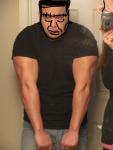A couple of interesting articles on the subject, challenging the conventional bro-lore:
The Myth of 1g/lb: Optimal Protein Intake for Bodybuilders | Bayesian Bodybuilding
âHow Much Proteinâ by Brad Pilon Book Review | Bayesian Bodybuilding
User Tag List
Results 1 to 10 of 40
Thread: Protein Intake - How Much?
-
01-21-2013 #1Established Member Feedback Score 0



- Join Date
- Nov 2012
- Location
- Seoul, Korea
- Posts
- 744
- Mentioned
- 0 Post(s)
- Tagged
- 0 Thread(s)
Protein Intake - How Much?
Last edited by Sperwer; 01-21-2013 at 04:55 AM.
"The purpose of today's training is to defeat yesterday's understanding."
-
01-21-2013 #2A 1k Club Member Feedback Score 0



- Join Date
- Nov 2012
- Posts
- 1,358
- Mentioned
- 0 Post(s)
- Tagged
- 0 Thread(s)
Nice one Sperwer!!! I think I needed to read this. Def gonna try to lower my protein intake some more to see if this will take me to the lean-level I want to be.
Anyone by chance know how much protein you usually get for:
100g Chicken Breast
100g Turkey Breast
100g Salmon
100g Tilapia
100g Grouper
I've read different number on different websites. But I believe 100g is usually around 20g of protein? correct?
And also, 5 egg whites and 1 whole egg should be just about 24g of protein right?
(not trying to highjack this thread, just that after reading this, I gotta get some facts straight to make some changes after my current PCT run)
-
01-21-2013 #3SwoleSource Member Feedback Score 0



- Join Date
- Dec 2012
- Posts
- 17
- Mentioned
- 0 Post(s)
- Tagged
- 0 Thread(s)
-
01-21-2013 #4Established Member Feedback Score 1 (100%)



- Join Date
- Nov 2012
- Location
- Texas
- Posts
- 720
- Mentioned
- 0 Post(s)
- Tagged
- 0 Thread(s)
Most of those citations are very, very weak in terms of length of study (very little will be observed in small populations and short periods of time) and Oly/PL'ing has only limited crossover to BB'ing in terms of actual training performed.
One thing the author only briefly touched upon and is not something that is minute is overall caloric balance. Many people substitue carb calories for fats/protein calories to control insulin levels. The author makes no mention of what to substitute for these calories and, let's be honest, is going against the grain in order to stand out.M. Ed. Ex Phys
-
01-21-2013 #5A 1k Club Member Feedback Score 0



- Join Date
- Nov 2012
- Posts
- 1,358
- Mentioned
- 0 Post(s)
- Tagged
- 0 Thread(s)
Rodja,
With your knowledge and experience in this, you're saying protein per bodyweight (lbs), should variate depending on whether it's a high carb day, or a low to no carb day, to serve as a substitute for the lack of Carb calories, Did i understand that correct?
If so, what according to your understanding and practice is a good ratio per day for protein intake on a High Carb day in comparison to a no carb day? Both if you are hormone free, and when you are on hormones (Just wondering how more your system can take when you're on a cycle).
Does not have to be exact science, but an estimate
-
01-21-2013 #6Super Moderator Feedback Score 2 (100%)




- Join Date
- Nov 2012
- Location
- OH CANADA
- Posts
- 1,383
- Mentioned
- 0 Post(s)
- Tagged
- 0 Thread(s)
on this subject ill go with bro lore over the posted studies
i dont believe you need 2g+ per pound, but i dont believe less than a gram is effective either
-
01-21-2013 #7
-
01-21-2013 #8Established Member Feedback Score 3 (100%)



- Join Date
- Nov 2012
- Location
- Ohio
- Posts
- 476
- Mentioned
- 0 Post(s)
- Tagged
- 0 Thread(s)
I have Pilan's Ebook. Overall its a good composition with enough supporting material to at least think about what he is presenting. Its much better then that blog post IMO. He also spends time basically recalling some of his own stories that I could have done without. If you remove the story portions there's probably only 50% of the book left. Also there's a portion of the book that states what most already know and thats that creatine works. (to sum it up) Overall its an interesting read. They have several other products that are decent reads as well. I would give this one a 6/10 for having solid info in it that IS based off his interpretation of the research. All of his citations and references are listed bellow reprinted directly from the text.
Also About the author I have some experience with him and there "phi life" group and they really aren't a bad group, very positive overall. But they are running a business. They don't really bash bodybuilding or "bro science" but they do spend a great deal of time say 90% trying to speak out against the current stereotypes.
Abe T, DeHoyos DV, Pollock ML, et al. Time course of strength and
muscle thickness changes following upper and lower body resistance
training in men and women. Eur J Appl Physiol 2000;81:174-80.
Abe T, Kohima K, Kearns CG, Yohena H and Fukuda J. Whole body
muscle hypertrophy from resistance training: distribution and total
mass. Br J Sports Med 2003;37(6):543-545
Adams GR, Caiozzo VJ, Haddad F, Baldwin KM. Cellular and molecular
responses to increased skeletal muscle loading after irradiation. Am J
Physiol Cell Physiol. 2002 Oct;283(4):C1182-95.
Atherton PJ, Etheridge T, Watt PW, Wilkinson D, Selby A, Rankin D,
Smith K, Rennie MJ. Muscle full effect after oral protein: time-dependent
concordance and discordance between human muscle protein synthesis
and mTORC1 signaling. Am J Clin Nutr. 2010 Nov;92(5):1080-8.
Becque DM Lochmann JD, Melrose DR. effects of oral creatine
supplementation on muscular strength and body composition. Med Sci
Sports Exerc 2000 32(3) 654-658
Bemben MG, Bemben DA, Loftiss DD, Knehans AW. Creatine
supplementation during resistance training in college football athletes.
Med Sci Sports Exerc 2001 33(10) 1667-1673.
Bennet WM, Connacher AA, Serimgeour CM, Smith K, Rennie MJ.
Increase in anterior tibialis muscle protein synthesis in healthy man
during mixed amino acid infusion: studies of incorporation of [l-
13C]leucine. ClinSci (lond) 1989;76:447-454
Bhasin s, Stoer TW, Berman N, Callegari C, Clevenger B, et al. The
effects of supraphysiologic doses of testosterone on muscle size and
strength in normal men. 1996; N Engl J Med: 335:1-7
Bhasin S, Woodhouse L, Casaburi R, Singh AB, Mac RP et al. Older men
are as responsive as young me to the anabolic effects of graded doses of
testosterone on the skeletal muscle. J Clin Endocrin metab.
2005;90(2):678-688
Bickel CS, Cross JM, Bamman MM. Exercise dosing to retain resistance
training adaptations in young and older adults. Med Sci Sports Exerc.
2011 Jul;43(7):1177-87.
Bohe J, Low A, Wolfe RR and Rennie MJ. Human muscle protein
synthesis is modulated by extracellular, not intracellular amino acid
availability: a dose-response study. J Physiol 552:315-324, 2003.
Bohé J, Low JF, Wolfe RR, Rennie MJ. Latency and duration of
stimulation of human muscle protein synthesis during continuous
infusion of amino acids. J Physiol. 2001 Apr 15;532(Pt 2):575-9.
Burd NA, West DW, Moore DR, Atherton PJ, Staples AW, Prior T, Tang
JE, Rennie MJ, Baker SK, Phillips SM. Enhanced amino acid sensitivity
of myofibrillar protein synthesis persists for up to 24 h after resistance
exercise in young men. J Nutr. 2011 Apr 1;141(4):568-73.
Burke DG, Chilibeck PD, Davison KS, Candow DG, Farthing J, Palmer
TS. The effect of whey protein supplementation with and without creatine
monohydrate combine with resistance training on lean tissue mass and
muscle strength.International Journal of Sports Nutrition and
Metabolism. 2001 11 349-364
Campbell WW, Crim MC, Dallal GE, Young VR, Evans WJ. Increased
protein requirements in elderly people: new data and retrospective
reassessments. Am J Clin Nutr. 1994 Oct;60(4):501-9.
Campbell WW, Trappe TA, Wolfe RR, Evans WJ. The recommended
dietary allowance for protein may not be adequate for older people to
maintain skeletal muscle. J Gerontol A Biol Sci Med Sci. 2001
Jun;56(6):M373-80.
Castaneda C, Gordon PL, Fielding RA, Evans WJ, Crim MC. Marginal
protein intake results in reduced plasma IGF-I levels and skeletal muscle
fiber atrophy in elderly women. J Nutr Health Aging. 2000;4(2):85-90.
Castaneda C, Gordon PL, Uhlin KL, Levey AS, Kehayias JJ, et al.
Resistance training to counteract the catabolism of a low-protein diet in
patients with chronic renal insufficiency. Ann Intern Med 2001;135:965-
Chargé SB et al. Cellular and molecular regulation of muscle
regeneration. Physiol Rev. (2004)
Chittenden RH. Physiologic economy in nutrition. New York: Heinemann,
Chromiak JA, Smedley B, Carpenter W, Brown R, Koh YS, Lamberth JG,
Joe LA, Abadie BR, Altorfer G. Effect of a 10-week strength training
program and recovery drink on body composition, muscular strength and
endurance, and anaerobic power and capacity. Nutrition. 2004
May;20(5):420-7.
Chrusch MJ, Chilibeck PD, Chad KE, Davison SK, Burke DG. Creatine
suppleenation combined with resistance training in older men. Med Sci
Sports Exerc 2001 33(12) 2111-2117.
Colker CM, Swain MA, Fabrucini B, Shi Q, Kalman DS. Effects of
supplemental protein on body composition and muscular strength in
healthy athletic male adults.
Cureton KJ, Collins MA, Hill DW, et al. Muscle hypertrophy in men and
women. Med Sci Sport Exerc 1988; 20:338-44.
Cuthbertson D, Smith K, Babraj J, Leese G, Waddell T, Atherton P,
Wackerhage H, Taylor PM, Rennie MJ. Anabolic signaling deficits
underlie amino acid resistance of wasting, aging muscle. FASEB J. 2005
Mar;19(3):422-4.
Cuthbertson DJ, Babraj J, Smith K, Wilkes E, Fedele MJ, Esser K,
Rennie M. Anabolic signaling and protein synthesis in human skeletal
muscle after dynamic shortening or lengthening exercise. Am J Physiol
Endocrinol Metab. 2006 Apr;290(4):E731-8.
Donnelly JE, Sharp T, Hourmard J, et al. Muscle Hypertrophy with largescale
weight loss and resistance training. Am J Clin Nutr 1993. 58;561-
Esmarck B, Anderson JL, Olsen S, Richter EA, Mizuno M, Kjaer M.
Timing of postexercise protein intake is important for muscle
hypertrophy with resistance training in elderly humans. J. Physiol.
2001:535.1;301-311.
Finkelstein JW, Roffwarg HP, Boyar RM, Kream J, Hellman L. Age-related
change in the twenty-four-hour spontaneous secretion of growth
hormone. J Clin Endocrinol Metab. 1972 Nov;35(5):665-70.
Fulgoni VR. Current protein intake in America: analysis of the National
Health and Nutrition Examination Survey, 2003–2004 American Journal
of Clinical Nutrition, Vol. 87, No. 5, 1554S-1557S, May 2008
Garlick PJ, McNurlan MA, Patlak CS. Adaptation of protein metabolism
in relation to limits to high dietary protein intake. Eur J Clin Nutr. 1999
Apr;53 Suppl 1:S34-43.
Garlick PJ, McNurlan MA. Measurement of protein synthesis in human
tissues by the flooding method. Curr Opin Clin Nutr Metab Care. 1998
Sep;1(5):455-60.
Garlick PJ, Millward DJ, James WP. The diurnal response of muscle and
liver protein synthesis in vivo in meal-fed rats. Biochem J. 1973
Dec;136(4):935-45.
Garlick PJ, Millward DJ, Waterlow JC. Protein turnover in cardiac and
skeletal muscle. J Physiol. 1973 Jun;231(2):101P-102P
Giustina A, Veldhuis JD. Pathophysiology of the neuroregulation of
growth hormone secretion in experimental animals and the human.
Endocr Rev. 1998 Dec;19(6):717-97.
Goldberg AL, etlinger JD, Goldspink DF, Jablecki C. Mechanism of workinduced
hypertrophy of skeletal muscle. Med. SCi. Sports. Exerc. 1975
7:248-61.
Greenhaff PL, et al. Disassociation between the effects of amino acids
and insulin on signaling, ubiquitinligases, and protein turnover in
human muscle. Am J PhysiolEndocrinolMetab. 2008 Sep;295(3):E595-
Hansen RD, Raja C, Allen BJ. Total body protein in chronic diseases and
in aging. Ann N Y Acad Sci. 2000 May;904:345-52.
Hartman JW, et al. Consumption of fat-free milk after resistance exercise
promotes greater lean mass accretion than does consumption of soy or
carbohydrate in young, novice, male weight lifters. Am J ClinNutr. 2007;
86:373-381
Hartman JW, Moore DR, Phillips SM. Resistance training reduces wholebody
protein turnover and improves net protein retention in untrained
young males. Appl Physiol Nutr Metab. 2006 Oct;31(5):557-64.
Hegsted DM. Letter: Protein and amino acid requirements of chicks, rats
and man. J Nutr. 1976 Sep;106(9):1377.
Hegsted DM. Protein needs and possible modifications of the American
diet. J Am Diet Assoc. 1976 Apr;68(4):317-20.
Hoffman JR, Ratamess NA, Kang J, Falvo MJ, Faigenbaum AD. Effect of
protein intake on strength, body composition and endocrine changes in
strength/power athletes. Journal of the International society of Sports
Nutrition 3(2):12-18, 2006.
Heyll U. The "Fight over the Protein Minimum". The conflict between
scientific nutrition teaching and food reform in 19th and 20th century
Germany. Dtsch Med Wochenschr. 2007 Dec;132(51-52):2768-73.
Hunter GR, Byrne NM, Sirikul B, et al. Resistance training conserves fatfree
mass and resting energy expenditure following weight loss. Obesity
2008;16:1045-1051.
Hutson SM, Harris RA. Introduction. Symposium: Leucine as a
nutritional signal. J Nutr. 2001 Mar;131(3):839S-840S
J Gerontol A Biol Sci Med Sci. 2001 Nov;56(11):M724-30.
Jefferson LS, Kimball SR. Amino acid regulation of gene expression. J
Nutr. 2001 Sep;131(9 Suppl):2460S-6S; discussion 2486S-7S.
Kadi F, Charifi N, Denis C, Lexell J. Satellite cells and myonuclei in
young and elderly women and men.Muscle Nerve. 2004 Jan;29(1):120
Kadi F, Eriksson A, Holmner S, Butler-Browne GS, Thornell LE. Cellular
adaptation of the trapezius muscle in strength-trained athletes.
Histochem Cell Biol. 1999 Mar;111(3):189-95.
Kadi F, Eriksson A, Holmner S, Thornell LE. Effects of anabolic steroids
on the muscle cells of strength-trained athletes. Med Sci Sports Exerc.
1999 Nov;31(11):1528-34.
Kadi F, Schjerling P, Andersen LL, Charifi N, Madsen JL, Christensen LR,
Andersen JL. The effects of heavy resistance training and detraining on
satellite cells in human skeletal muscles. J Physiol. 2004 Aug 1;558(Pt3):1005-12.
Kosek DJ, Kim JS, Petrella JK, Cross JM, Bamman MM. Efficacy of 3
days/wk resistance training on myofiber hypertrophy and myogenic
mechanisms in young vs. older adults. J Appl Physiol. 2006
Aug;101(2):531-44.
Kraemer WJ, Hakkinen K, Triplett-McBride NT, Fry AC, Koziris LP, et al.
Physiolgoical changes with periodized resistance training in women
tennis players. Med SCi Sports Exerc. 2003;35(1):157-168.
Lemon PW, Tarnopolsky MA, MacDougall JD, Atkinson SA. Protein
requirements and muscle mass/strength changes during intensive
training in novice bodybuilders. J Appl Physiol. 1992 Aug;73(2):767-75.
Louis M, Poortmans JR, Francaux M, Hultman E, Berre J, et al. Creatine
supplementation has no effect on human muscle protein turnover at rest
in the postabsorptive or fed states. Am J Physiol Endocrinol
Metab:284;765-770.
Luff AR, Atwood HL. Changes in the sarcoplasmic reticulum and
transverse tubular system of fast and slow skeletal muscles of the mouse
during postnatal development. J Cell Biol. 1971 Nov;51(21):369-83.
Lui JC, Baron J. Mechanisms limiting body growth in mammals. Endocr
Rev. 2011 Jun;32(3):422-40.
McKay BR, Toth KG, Tarnopolsky MA, Parise G. Satellite cell number and
cell cycle kinetics in response to acute myotrauma in humans:
immunohistochemistry versus flow cytometry. J Physiol. 2010 Sep
1;588(Pt 17):3307-20.
Millward DJ, Price GM, Pacy PJ, Halliday D. Maintenance protein
requirements: the need for conceptual re-evaluation. Proc Nutr Soc. 1990
Oct;49(3):473-87.
Millward DJ. The hormonal control of protein turnover. Clin Nutr. 1990
Jun;9(3):115-26.
Moore DR, Robinson MJ, Fry JL, Tang JE, Glover EI, Wilkinson SB, Prior
T, Tarnopolsky MA, Phillips SM. Ingested protein dose response of
muscle and albumin protein synthesis after resistance exercise in young
men. Am J Clin Nutr. 2009 Jan;89(1):161-8.
Moore DR, Tang JE, Burd NA, Rerecich T, Tarnopolsky MA, Phillips SM.
Differential stimulation of myofibrillar and sarcoplasmic protein
synthesis with protein ingestion at rest and after resistance exercise. J
Physiol. 2009 Feb 15;587(Pt 4):897-904.
Morse MH, Haub MD, Evans WJ, Campbell WW. Protein requirement of
elderly women: nitrogen balance responses to three levels of protein intake. J
Gerontol A Biol Sci Med Sci. 2001 Nov;56(11):M724-30.
Munro HN, McLean JT, Hird HJ. Effect of protein intake on the
ribonucleic acid of liver cell SAP. J Nutr. 1964 Jul;83:186-92. No
abstract available.
Nutritional Supplements in the U.S. Packaged Facts. November 1, 2006
Paul GL. Dietary protein requirements of physically active individuals.
Sports Med. 1989 Sep;8(3):154-76. Review.
Petrella JK, Kim JS, Cross JM, Kosek DJ, Bamman MM. Efficacy of
myonuclear addition may explain differential myofiber growth among
resistance-trained young and older men and women. Am J Physiol
Endocrinol Metab. 2006 Nov;291(5):E937-46. Epub 2006 Jun 13.
Petrella JK, Kim JS, Mayhew DL, Cross JM, Bamman MM. Potent
myofiber hypertrophy during resistance training in humans is associated
with satellite cell-mediated myonuclear addition: a cluster analysis. J
Appl Physiol. 2008 Jun;104(6):1736-42. Epub 2008 Apr 24.
Phillips SM, Parise G, Roy BD, Tipton KD, Wolfe RR, and Tarnopolsy MA,
Resistance-training induced adaptations in skeletal muscle protein
turnover in the fed state. Can J PhysiolPharmacol 80: 1045-1053
Phillips SM, Tipton KD, Aarsland A, Wolf SE, Wolfe RR. Mixed muscle
protein synthesis and breakdown after resistance exercise in humans.
Am J Physiol 1997;273(36):E99-E107
Phillips SM, Tipton KD, Ferrando AA and Wolfe RR 1999. Resistance
training reduces the acute exercise-induced increase in muscle protein
turnover. AM J Physiol 276: E118-E124.
Phillips SM, Tipton KD, Ferrando AA, Wolfe RR. Resistance training
reduces the acute exercise-induced increase in muscle protein turnover.
Am J Physiol. 1999 Jan;276(1 Pt 1):E118-24.
Phillips SM. Dietary protein for athletes: from requirements to metabolic
advantage. Appl Physiol Nutr Metab. 2006 Dec;31(6):647-54.
Potter J, Langhorne P, Roberts M. Routine protein energy
supplementation in adults: systematic review. The British Medical
Journal.1998; 517:495-501.
Rasmussen BB, Tipton KD, Miller SL, Wolf SE, Wolfe RR. An oral
essential amino acid-carbohydrate supplement enhances muscle protein
anabolism after resistance exercise. J Appl Physiol. 2000:88;386-392.
Robertson TA, Grounds MD, Mitchell CA, Papadimitriou JM. Fusion
between myogenic cells in vivo: an ultrastructural study in regenerating
murine skeletal muscle. J Struct Biol. 1990 Oct-Dec;105(1-3):170-82.
Robinson SM, Jaccard C, Persaud C, Jackson AA, Jequier E &Schutz Y.
Protein turnover and thermogenesis in response to high-protein and
high-carbohydrate feeding in men. Am. J. Clin. Nutr. 1990;52: 72-80.
Rosenblatt JD, Parry DJ. Gamma irradiation prevents compensatory
hypertrophy of overloaded mouse extensor digitorum longus muscle. J
Appl Physiol. 1992 Dec;73(6):2538-43.
Sinha-Hikim I, Roth SM, Lee MI, Bhasin S. Testosterone-induced muscle
hypertrophy is associated with an increase in satellite cell number in
healthy, young men. Am J Physiol Endocrinol Metab. 2003
Jul;285(1):E197-205.
Smith GI, Patterson BW, Mittendorfer B. Human muscle protein
turnover--why is it so variable? J Appl Physiol. 2011 Feb;110(2):480-91.
Smith K, Reynolds N, Downie S, Patel A, Rennie MJ. Effects of flooding
amino acids on incorporation of labeled amino acids into human muscle
protein. Am J Physiol. 1998: 275; E73-E78.
Stote KS, Baer DJ, Spears K, Paul DR, Harris GK, et al. A controlled trial
of reduced meal frequency without caloric restriction in healthy, normalweight,
middle aged men. AM J Clin Nutr 2007;85:981-988.
Tarnopolsky MA, Atkinson SA, MacDougall JD, Chesley A, Phillips S,
Schwarcz HP. Evaluation of protein requirements for trained strength athletes.
J Appl Physiol. 1992 Nov;73(5):1986-95.
Tarnopolsky MA, MacDougall JD, Atkinson SA. Influence of protein
intake and training status on nitrogen balance and lean body mass. J
Appl Physiol. 1988 Jan;64(1):187-93.
Tarnopolsky MA, Parise G, Yarkely NJ, Ballantyne CS, Olatunji S,
Phillips SM.Creatine-dextrose and protein-dextrose indue similar
strength gains during training. Med Sci Sports Exerc 2001 33(12) 2044-2052
Thalacker-Mercer AE, Dell'Italia LJ, Cui X, Cross JM, Bamman MM.
Differential genomic responses in old vs. young humans despite similar
levels of modest muscle damage after resistance loading. Physiol
Genomics. 2010 Feb 4;40(3):141-9.
Thalacker-Mercer AE, Petrella JK, Bamman MM. Does habitual dietary
intake influence myofiber hypertrophy in response to resistance training?
A cluster analysis. Appl Physiol Nutr Metab. 2009 Aug;34(4):632-9.
Thomis MA, Beunen GP, Maes HH, Blimkie CJ, Van Leemputte M,
Claessens AL, Marchal G, Willems E, Vlietinck RF. Strength training:
importance of genetic factors. Med Sci Sports Exerc. 1998
May;30(5):724-31.
Thomis MA, Beunen GP, Van Leemputte M, Maes HH, Blimkie CJ,
Claessens AL, Marchal G, Willems E, Vlietinck RF. Inheritance of static
and dynamic arm strength and some of its determinants. Acta Physiol
Scand. 1998 May;163(1):59-71.
Tipton KD, Ferrando AA, Phillips SM, Dolye D, Wolfe RR. Postexercise
net protein synthesis in human muscle from orally administered amino
acids. Am J Physiol. 1999; 276: E628-E634.
Tipton KD, Rasmussen BB, Miller SL, Wolf SE, Owens-Stovall SK, Petrini
BE, Wolfe RR. Timing of amino acid-carbohydrate ingestion alters
anabolic response of muscle to resistance exercise. Am J Physiol
Endocrinol Metab. 2001 Aug;281(2):E197-206.
Todd KS, Butterfield GE, Calloway DH. Nitrogen balance in men with
adequate and deficient energy intake at three levels of work. J Nutr. 1984
Nov;114(11):2107-18.
Toth KG, McKay BR, De Lisio M, Little JP, Tarnopolsky MA, Parise G. IL-
6 induced STAT3 signaling is associated with the proliferation of human
muscle satellite cells following acute muscle damage. PLoS One. 2011
Mar 9;6(3):e17392.
Treuth MS, Ryan AS, Pratley RE, Rubin MA, Miller JP, Nicklas BJ,
Sorkin J, Harman SM, Goldberg AP, Hurley BF. Effects of strength
training on total and regional body composition in older men. J Appl
Physiol. 1994 Aug;77(2):614-20.
Waterlow JC. Observations on the mechanism of adaptation to low
protein intakes. Lancet. 1968 Nov 23;2(7578):1091-7.
Young VR. Regulation of protein synthesis and skeletal muscle growth. J
Anim Sci. 1974 May;38(5):1054-70
-
01-21-2013 #9Established Member Feedback Score 1 (100%)



- Join Date
- Nov 2012
- Posts
- 741
- Mentioned
- 0 Post(s)
- Tagged
- 0 Thread(s)
I like the article posted, only because for me it's suited well. I'm also with dj, and I will still go with brolore and skip the scientific jargon. Somewhere between what science says, what the gym rats say, and your own personal experience, find your own happy medium. Unless your super serious, just go by rule of thumb.
-
01-21-2013 #10




 Reply With Quote
Reply With Quote






